German technichians continued after the war their work in Spain with a rifle with delayed blowback. This Cetme rifle was initially chambered for the kurz patrone. A few years later the Cetme rifle adopted the 7.62 mm Nato cartridge, so the kurz cartridges were only made for tests and are consequently rare. The principal equipment formed for the manufacture and study of the ammunition that the new CETME was going to use was directed by Ludwig Vorgrimler, a former technician of the German Mauser factory during the WWII. The rest of the technical personnel was formed by Spanish and Germans of diverse specialities.
Also a special cartridge was designed a step before the development of the CETME. The development of this cartridge was entrusted to an team headed by doctor Voss, a German technician specializing in ammunition and one of the more international prestige of the technician contracted by CETME. His more outstanding collaborator would be the spanish lieutenant colonel Gonzalez Alvarez. The characteristics of the cartridge were: pod cuts, very light and aerodynamic bullet and special gunpowder of small weight. The ammunition developed by the ballistic equipment of the doctor Voss was revolutionary, since it had a few ballistic caracterisiticas never reached by another cartridge of this type. His investigations were always going ahead of the realized ones for the equipment of the CETME, advancing constant the obtained information. Finally there was obtained a cartridge of 7.92x40 (named model 1950) and it was decided to construct in the National Factory of Palencia a sufficient quantity to realize some of the first tests of the CETME. The gunpowder was designed and produced in the National Factory of gunpowders of Granada city, because a production in other countries could not give the demanded results.
Doctor Voss also designed in Spain in 1955 a cartridge for the German borderpolice, called “Cartucho de Policía CH-002”, in 7.62x40 mm
The Spanish lieutemant colonel Calzada Bayo was the one that employed more efforts in Spain in the development of ammunition of 7.92x33 kurz. He started his work in March, 1951 and after only three months, he presented "The mosquetón semiautomatically CB-51 cal 7.92x33 kurz" identical to the Spanish Mauser mod. 1943, but shorter, lighter and with simpler mechanisms. After a few initial tests there was ordered manufacture of 10 units with corresponding ammunition and gunpowder made in the La Coruña city. On December 18., 1952 tests were still realized of this weapon, but there were problems to get the neccesary quantity of ammunition. The ammunition was finally designed in the military factory of La Coruña city (Cartucho CB-51 7.92 kurz) because of a delay in the factory of the Palencia city, but nevertheless there were always difficulties to have enough ammunition to make the necessary tests.
Below a summary of types and years of production of the kurz and variants made in Spain:
1 st: In the year 1949 experimental works started with the Cetme rifle. First Spanish kurz made at the ammunition plant "Fábricia Nacional de Palencia". Possible headstamps: FNP 7.92 - 949. Same model and dimensions as the German cartridge.
It's certain that cartridges were produced in 1950 (FNP 7.92 - 950). Several thousands were produced in 25 round boxes for the German technicians working in Spain.
2 nd: The years 1951, 1952, 1953, 1954? and 1955 and maybe later. Some made for the Cetme and other for experimental weapons of lieutemant colonel in the Spanish army Calzada Bayo. The headstamps were: FNP 7.92 - 951, FNP 7.92 - 952, FNP 7.92 - 953 and FNP 7.91 - 955 and maybe FNP 7.92 - 954. Same model and dimensions as the German cartridge. A lot of variants were made.
3 rd: Officially made in 1968. Made for experimental weapons of lieutemant colonel González Regaña. A subcaliber. Too long to shoot in a MP44. (this cartridge has a length of 53 mm versus the 47,1 mm for the normal German round). Possible headstamp: FNP 7.92 - 968. This headstamp is mentioned in colonel Lanza's ammunition catalog "Nuevo Catalogo Lanza" along with the types mentioned above, and the "bala larga para ejercicio" (nickel case) from 1951, the "bala pesada trazadora" from 1951 and the "bala pesada trazadora verde" from 1955 have all the same bullet dimensions as the model of González Regaña.
Note that the initial speed of the Spanish kurz is much lower than the speed of the wartime German kurz. 450 m/s versus 690 m/s. The long (and heavier) bullet Spanish kurz has an even lower speed: 220 m/s.
| Year | Caliber | Spanish denomination | Design and factory | Bullet composition | Bullet weight | Bullet length | Velocity | Cartridge weight and length | Distance maximum - effective |
| 1949 | 7.92 x 33 | MP44-1 ordinaria | FNP | Brass and soft iron core | 8 g | 25.8 mm | 450 m/s | 17 g - 47 mm | 1500 m - 250 m |
| 1951 | 7.92 x 33 | CB-51 ordinaria | Calzada bayo FNP | Brass and lead | 8 g | 20 mm | 450 m/s | 17 g - 47 mm | 1500 m - 250 m |
Thanks to Manuel Rubio and Jordi Camerón i Vinaixa for all the information
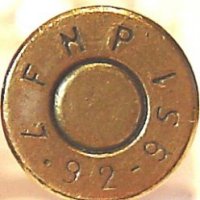 |
Ordinaria Normal model and the dimensions are totally indentical to the German kurz. Length 47.1 mm, bullet made of brass (tombac), lead and with a soft iron core. Pictured cartridge made in 1951. Lanzas catalog: #1601. V0= 450 m/s |

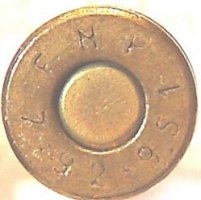 |
Torneada The name refers to the shape of the bullet. The rear end of the bullet is of the "boat tail type". The bullet weight is the same as "ordinaria" - 8.0 grams, and is otherwise identical to "ordinaria". Pictured cartridge made in 1951. Lanzas catalog: #1611. V0= 450 m/s |

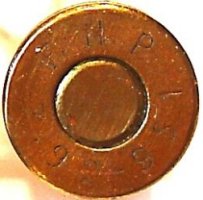 |
Calzada Bayo The name refers to the lieutenat colonel who designed it. As "ordinaria" but the bullet is short with a lead core. Bullet weight: 8.0 grams. Pictured cartridge made in 1951. Lanzas catalog: #1602. V0= 450 m/s |

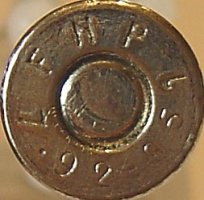 |
Bala corta para ejercicio Cartridge made of nickel for exercise. Dimensions as "ordinaria". Pictured cartridge made in 1951. Lanzas catalog: #1614. |

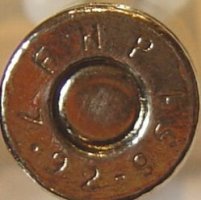 |
Bala larga para ejercicio Exercise cartridge made of nickel. Bullet longer compared to "corta". Total length: 53 mm Pictured cartridge made in 1951. (or perhaps only the case made in 1951) Lanzas catalog: Not mentioned |

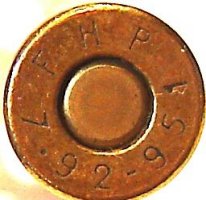 |
Pesada An "ordinario" with a long bullet - weight 12.7 grams. The bullet weight corresponds to the German sS bullet. (a copy of the German bullet ?). Total length: 53 mm. Pictured case made in 1951. (and then perhaps assembled in 1968 ?) Lanzas catalog: #1605. V0= 220 m/s |

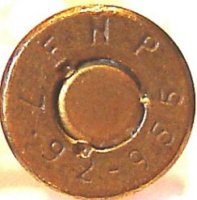 |
Bala pesada trazador rojo A subcalibre tracer round with red tipped bullet. Bullet weight: 10.9 g. Total length: 53 mm. Case made in 1955. Lanzas catalog: #1606. V0= 220 m/s |

 |
Bala pesada trazador verde A tracer round with green tipped bullet. Bullet weigt: 10.9 g. Total length: 53 mm. Case made in 1951. Lanzas catalog: #1606. V0= 220 m/s |

| Back to the main page |